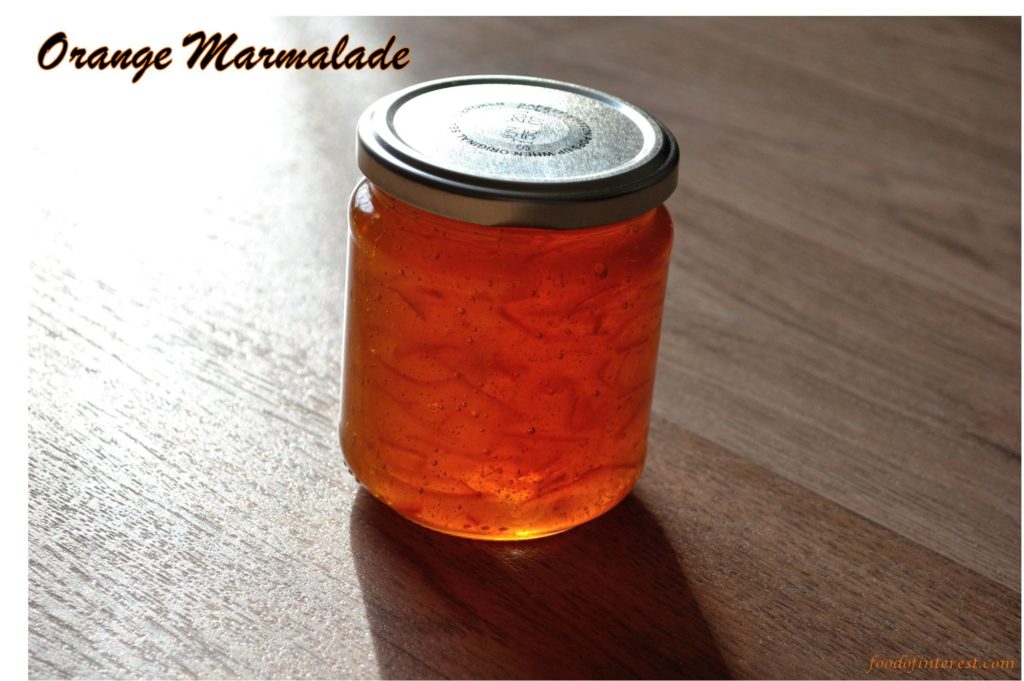Orange marmalade is a fruit preserve made with oranges(obviously) and lemon, boiled with sugar till it is set. The speciality of a marmalade is peels or shreds of skin are added to get all the flavour of the fruit. Use organic fruits where possible especially when consuming the skins or peels. Preserving sugar or regular granulated sugar can be used. Lemon juice cuts through the sweetness of the oranges and gives a nice zing between orange flavours. Taste the oranges before making the marmalade, if the juice is bitter try avoiding those oranges. I learnt to make this from a recipe published by a supermarket. They make it in bulk, I have adapted the recipe to yield about 400-450 gm of marmalade. Orange marmalade on buttered toast is the best way to eat this. I also make other jams like, strawberries, cranberries, mixed fruits, mango morabba(gulambu), grapes, will post them all soon.
- 450-500 Gm Oranges (Jam orange like Seville variety)
- 1 big lemon
- 750 Gm preserving sugar or regular granulated white sugar (not jam sugar)
- Wash the oranges and lemon thoroughly. Dry them with clean kitchen towels or air dry them for a while. Cut them into halves. Juice the oranges and lemon in a mixing bowl. Pour about 250-300 ml of water in this mixing bowl
- Do not discard squeezed out orange skins, discard the lemon skin. Scoop out the pith from the orange halves and tie these into a clean muslin cloth. All flavour that can be extracted will make the marmalade taste fresh and orangey! Tie the muslin cloth from the edges and make a pouch. In another pan, add half a litre of water and add this pouch into the water
- With a sharp knife slice the orange skins into thin long strips or shreds. Add these shreds of orange skins into the juices into the mixing bowl of orange and lemon juice. Leave the mixing bowl overnight. Cover and keep in a cool place
- The next day, remove the pouch from the other pan and squeeze out as much juice as possible . Use a spoon for this
- To this pan, add the contents of the mixing bowl. Orange, lemon juice and shreds of orange skin
- Bring to a boil. Lower the heat to medium. Add sugar, mix well. Marmalade starts changing colour, it becomes thicker and turns deeper shade of orange colour. It takes about 20 minutes after first boil
- To test, remove the pan from the heat and take a little marmalade onto a chilled plate. Allow to cool for a few seconds, then push with your finger. If the surface wrinkles it is ready, else boil for few more minutes (3-4 minutes) and test again.
- Leave the marmalade to settle for 15 minutes. Stir the mixture and pour into warm, sterilised jars
- Serve with warm rustic rolls or finger rolls or plain toast. Enjoy it with your cup of tea for breakfast
Do not use any preservatives, the sugar itself acts the preservative. Make in clean environment, marmalade lasts longer
Used and cleaned jam bottle can be used to store this marmalade. Wash in warm soap water, sterilize in hot water or just wash it off thorougly with hot water and leave to air dry in a warm place, with bottle sideways so no dust can enter the bottle directly. Do not touch or wipe the interior of the glass bottle when it is dry
Once jam is transferred to bottle store in cool dry place. When opened, store it back in refrigerator
Remember to keep the juices overnight
Thick cut marmalade can also be made, I prefer the fine variety where, orange peels are shred into thin strips it makes marmalade easily spreadable and flavours get distributed evenly
Stepwise:
Wash the oranges and lemon thoroughly. Dry them with clean kitchen towels or air dry them for a while. Cut them into halves. Juice the oranges and lemon in a mixing bowl. Pour about 250-300 ml of water in this mixing bowl
Do not discard squeezed out orange skins, discard the lemon skin. Scoop out the pith from the orange halves and tie these into a clean muslin cloth. All flavour that can be extracted will make the marmalade taste fresh and orangey! Tie the muslin cloth from the edges and make a pouch. In another pan, add half a litre of water and add this pouch into the water
With a sharp knife slice the orange skins into thin long strips or shreds. Add these shreds of orange skins into the juices into the mixing bowl of orange and lemon juice. Leave the mixing bowl overnight. Cover and keep in a cool place
The next day, remove the pouch from the other pan and squeeze out as much juice as possible . Use a spoon for this. To this pan, add the contents of the mixing bowl. Orange, lemon juice and shreds of orange skin
Bring to a boil. Lower the heat to medium. Add sugar, mix well. Marmalade starts changing colour, it becomes thicker and turns deeper shade of orange colour. It takes about 20 minutes after first boil
To test, remove the pan from the heat and take a little marmalade onto a chilled plate. Allow to cool for a few seconds, then push with your finger. If the surface wrinkles it is ready, else boil for few more minutes (3-4 minutes) and test again
Leave the marmalade to settle for 15 minutes. Stir the mixture and pour into warm, sterilised jars
Serve with warm rustic rolls or finger rolls or plain toast. Enjoy it with your cup of tea for breakfast
